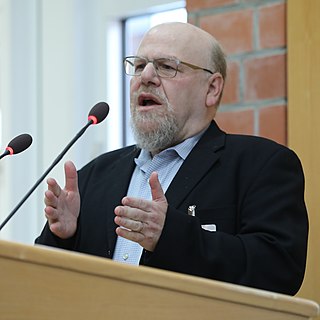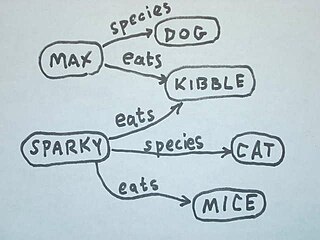Related Research Articles

The Semantic Web, sometimes known as Web 3.0, is an extension of the World Wide Web through standards set by the World Wide Web Consortium (W3C). The goal of the Semantic Web is to make Internet data machine-readable.
In information science, an ontology encompasses a representation, formal naming, and definitions of the categories, properties, and relations between the concepts, data, or entities that pertain to one, many, or all domains of discourse. More simply, an ontology is a way of showing the properties of a subject area and how they are related, by defining a set of terms and relational expressions that represent the entities in that subject area. The field which studies ontologies so conceived is sometimes referred to as applied ontology.
The DARPA Agent Markup Language (DAML) was the name of a US funding program at the US Defense Advanced Research Projects Agency (DARPA) started in 1999 by then-Program Manager James Hendler, and later run by Murray Burke, Mark Greaves and Michael Pagels. The program focused on the creation of machine-readable representations for the Web.
OIL can be regarded as an ontology infrastructure for the Semantic Web. OIL is based on concepts developed in Description Logic (DL) and frame-based systems and is compatible with RDFS.
Description logics (DL) are a family of formal knowledge representation languages. Many DLs are more expressive than propositional logic but less expressive than first-order logic. In contrast to the latter, the core reasoning problems for DLs are (usually) decidable, and efficient decision procedures have been designed and implemented for these problems. There are general, spatial, temporal, spatiotemporal, and fuzzy description logics, and each description logic features a different balance between expressive power and reasoning complexity by supporting different sets of mathematical constructors.
The Web Ontology Language (OWL) is a family of knowledge representation languages for authoring ontologies. Ontologies are a formal way to describe taxonomies and classification networks, essentially defining the structure of knowledge for various domains: the nouns representing classes of objects and the verbs representing relations between the objects.
RuleML is a global initiative, led by a non-profit organization RuleML Inc., that is devoted to advancing research and industry standards design activities in the technical area of rules that are semantic and highly inter-operable. The standards design takes the form primarily of a markup language, also known as RuleML. The research activities include an annual research conference, the RuleML Symposium, also known as RuleML for short. Founded in fall 2000 by Harold Boley, Benjamin Grosof, and Said Tabet, RuleML was originally devoted purely to standards design, but then quickly branched out into the related activities of coordinating research and organizing an annual research conference starting in 2002. The M in RuleML is sometimes interpreted as standing for Markup and Modeling. The markup language was developed to express both forward (bottom-up) and backward (top-down) rules in XML for deduction, rewriting, and further inferential-transformational tasks. It is defined by the Rule Markup Initiative, an open network of individuals and groups from both industry and academia that was formed to develop a canonical Web language for rules using XML markup and transformations from and to other rule standards/systems.

James Alexander Hendler is an artificial intelligence researcher at Rensselaer Polytechnic Institute, United States, and one of the originators of the Semantic Web. He is a Fellow of the National Academy of Public Administration.

The ultimate goal of semantic technology is to help machines understand data. To enable the encoding of semantics with the data, well-known technologies are RDF and OWL. These technologies formally represent the meaning involved in information. For example, ontology can describe concepts, relationships between things, and categories of things. These embedded semantics with the data offer significant advantages such as reasoning over data and dealing with heterogeneous data sources.
The DARPA agent markup language for services (DAML-S) is a semantic markup language for describing web services and related ontologies.
The Semantic Web Rule Language (SWRL) is a proposed language for the Semantic Web that can be used to express rules as well as logic, combining OWL DL or OWL Lite with a subset of the Rule Markup Language.
An RDF query language is a computer language, specifically a query language for databases, able to retrieve and manipulate data stored in Resource Description Framework (RDF) format.

Ian Robert Horrocks is a professor of computer science at the University of Oxford in the UK and a Fellow of Oriel College, Oxford. His research focuses on knowledge representation and reasoning, particularly ontology languages, description logic and optimised tableaux decision procedures.
OWL-S is an ontology built on top of Web Ontology Language (OWL) by the DARPA DAML program. It replaces the former DAML-S ontology. "OWL-S is an ontology, within the OWL-based framework of the Semantic Web, for describing Semantic Web Services. It will enable users and software agents to automatically discover, invoke, compose, and monitor Web resources offering services, under specified constraints."
Ekaterini Panagiotou Sycara is a Greek computer scientist. She is an Edward Fredkin Research Professor of Robotics in the Robotics Institute, School of Computer Science at Carnegie Mellon University internationally known for her research in artificial intelligence, particularly in the fields of negotiation, autonomous agents and multi-agent systems. She directs the Advanced Agent-Robotics Technology Lab at Robotics Institute, Carnegie Mellon University. She also serves as academic advisor for PhD students at both Robotics Institute and Tepper School of Business.
Machine interpretation of documents and services in Semantic Web environment is primarily enabled by (a) the capability to mark documents, document segments and services with semantic tags and (b) the ability to establish contextual relations between the tags with a domain model, which is formally represented as ontology. Human beings use natural languages to communicate an abstract view of the world. Natural language constructs are symbolic representations of human experience and are close to the conceptual model that Semantic Web technologies deal with. Thus, natural language constructs have been naturally used to represent the ontology elements. This makes it convenient to apply Semantic Web technologies in the domain of textual information. In contrast, multimedia documents are perceptual recording of human experience. An attempt to use a conceptual model to interpret the perceptual records gets severely impaired by the semantic gap that exists between the perceptual media features and the conceptual world. Notably, the concepts have their roots in perceptual experience of human beings and the apparent disconnect between the conceptual and the perceptual world is rather artificial. The key to semantic processing of multimedia data lies in harmonizing the seemingly isolated conceptual and the perceptual worlds. Representation of the Domain knowledge needs to be extended to enable perceptual modeling, over and above conceptual modeling that is supported. The perceptual model of a domain primarily comprises observable media properties of the concepts. Such perceptual models are useful for semantic interpretation of media documents, just as the conceptual models help in the semantic interpretation of textual documents.
Swoogle was a search engine for Semantic Web ontologies, documents, terms and data published on the Web. Swoogle employed a system of crawlers to discover RDF documents and HTML documents with embedded RDF content. Swoogle reasoned about these documents and their constituent parts and recorded and indexed meaningful metadata about them in its database.
WSML or Web Service Modeling Language is a formal language that provides a syntax and semantics for the Web Service Modeling Ontology (WSMO).

In computer science, information science and systems engineering, ontology engineering is a field which studies the methods and methodologies for building ontologies, which encompasses a representation, formal naming and definition of the categories, properties and relations between the concepts, data and entities of a given domain of interest. In a broader sense, this field also includes a knowledge construction of the domain using formal ontology representations such as OWL/RDF. A large-scale representation of abstract concepts such as actions, time, physical objects and beliefs would be an example of ontological engineering. Ontology engineering is one of the areas of applied ontology, and can be seen as an application of philosophical ontology. Core ideas and objectives of ontology engineering are also central in conceptual modeling.
Sheila McIlraith is a Canadian computer scientist specializing in Artificial Intelligence (AI). She is a Professor in the Department of Computer Science, University of Toronto. She is a Canada CIFAR AI Chair, a faculty member of the Vector Institute, and Associate Director and Research Lead of the Schwartz Reisman Institute for Technology and Society.
References
- ↑ Payne, Terry R. (1994). Learning Email Filtering Rules with Magi - A Mail Agent Interface (MSc).
- ↑ Payne, Terry R. (1999). Dimensionality Reduction and Representation for Nearest Neighbour Learning (PhD).
- ↑ DAML-S Coalition
- ↑ Payne, Terry; Lassila, Ora (2004). "Semantic Web Services". IEEE Intelligent Systems . 19 (1): 14–15. doi:10.1109/MIS.2004.29.
- ↑ OWL-S: Semantic Markup for Web Services
- ↑ DAML Services
- ↑ OWL-S: Semantic Markup for Web Services (W3C Submission)
- ↑ Martin, David; Paolucci, Massimo; McIlraith, Sheila; Burstein, Mark; McDermott, Drew; McGuinness, Deborah; Parsia, Bijan; Payne, Terry; Sabou, Marta; Solanki, Monika; Srinivasan, Naveen; Sycara, Katia (2005), Cardoso, Jorge; Sheth, Amit (eds.), "Bringing Semantics to Web Services: The OWL-S Approach" (PDF), Semantic Web Services and Web Process Composition, vol. 3387, Springer Berlin Heidelberg, pp. 26–42, doi:10.1007/978-3-540-30581-1_4, ISBN 978-3-540-24328-1
- ↑ Terry R. Payne publications indexed by Google Scholar